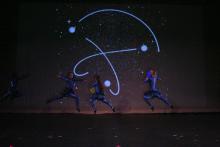
Abstract
The dynamics of gravitating astrophysical systems such as black holes and neutron stars are fascinatingly complex, offer some of nature's most spectacular phenomena, and capture the public's imagination in ways that few subjects can. Here, we describe AstroDance, a multi-media project to engage deaf and hard-of-hearing (DHH) students in astronomy and gravitational physics. AstroDance incorporates multiple means of representation of scientific concepts and was performed primarily for secondary and post-secondary audiences at ~20 venues in the northeastern US prior to the historic first detection of gravitational waves. As part of the AstroDance project, we surveyed ~1000 audience members roughly split evenly between hearing and DHH audience members. While both groups reported statistically equivalent high-rates of enjoyment of the performance, the DHH group reported an increase in how much they learned about science at a statistically significant rate compared to the hearing audience. Our findings suggest that multi-sensory approaches benefit both hearing and DHH audiences and enable accessible participation for broader groups.